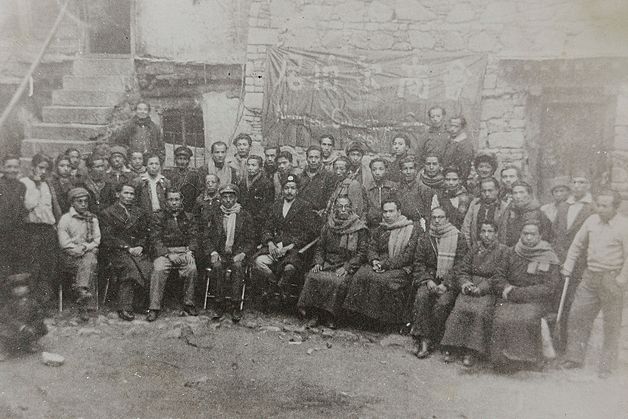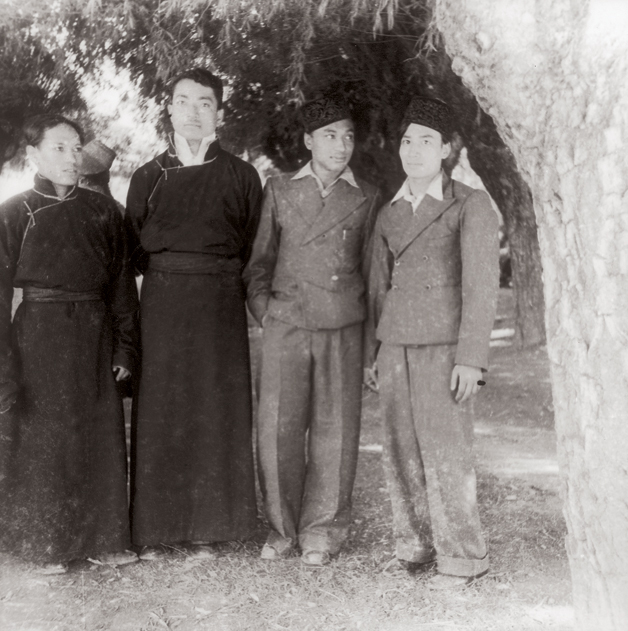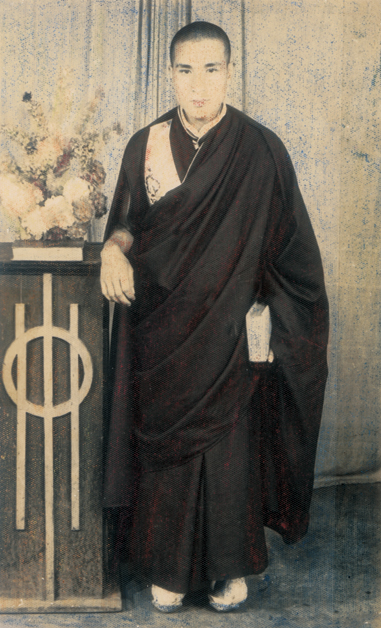
I first met Gyan Jyoti Kansakar when we persuaded him to break down the south wall of
his large property in Thamel to build a four-shutter house, so we could start a photo - processing lab there. He agreed to our proposal, and this subsequently led to his building spree. By removing the south wall completely, he added more shops adjacent to our outlet, Nepal Color Lab. He then destroyed the western wall to start a long row of shops opposite the J.P. School, which prompted the expansion of Thamel’s shops along what was once a potholed, neglected dirt road. Today along this road, you will find Himalatte Café, Jatra, Helena’s and many other well-established eateries.
There was something about Gyan Jyoti that set him apart from the other Newars of Kathmandu. One could feel it every time he spoke. The manner in which he spoke, his mentality and mannerisms were quite different. Getting to know him better, I later realized that he was a Lhasa Newar. They were a breed of hardy Newars who withstood the hardships of traveling through Himalayan passes and braved the harsh living conditions in Tibet. In the dual biography of the late Bhajuratna and late Gyan Jyoti “Syamukapu”, written by the latter’s daughter Dev Shova, he recalls being extremely depressed by the barrenness of the Tibetan plateau. Having lived many years in Lhasa and later in Kalimpong near Darjeeling, he was given to constantly comparing the people there and the locals here. His father, Bhajuratna, established their trading house in Lhasa, Kalimpong and Calcutta (now Kolkata) and was known to all in Tibet as “Syamukapu” (White Cap in Tibetan) derived from the hat he always wore.
It is said that the Nepal-Tibet trade was established when Princess Bhrikuti (daughter of a Lichhavi King Amshuvarma) was married off to the Tibetan King Songsten Gampo in the 7th Cent. AD. She was accompanied by a large number of traders and artisans. The traders were the pioneers who set up shop in the Tibetan capital and became known as the Lhasa traders. Their successors took to wearing Tibetan clothes, sported long hair and some even married Tibetan women. In time, people referred to these traders as Lhasa Newars.

Bhrikuti is believed to have pioneered the route to Tibet from the north of Kathmandu through Kyirong, a Tibetan border town. Kyirong was a trading post where the Nepali traders bartered rice for Tibetan salt. The other important route started from the little town of Sankhu at the edge of the valley. Going through Melamchi, the traders climbed over many hills and finally entered Tibet through Kodari. One of the hazards on the way was high altitude sickness for which the only cure is to quickly descend to a lower altitude. Later, when the route through Sikkim was opened, traders had to trek through the Nathula Pass (4,392m; this pass in the Indian border has been reopened recently by the Indian government) or through the Jarila Pass (4,880m; also known as Jalepla). The new route also made the route through Kathmandu less important as most of the trade goods came from Calcutta. But Kalimpong now gained importance, which explains the presence then, of Lhasa Newars in this little town in northern India.
Trade slowly developed among three players: Tibet, Nepal and India. Calcutta was the source of goods that were eventually sold in Lhasa. The middlemen were the Newars of Kathmandu, like the Kansakars, Tamrakars, Bajracharyas, Tuladhars, Shakyas, Dhakhwas and Shresthas, who established themselves in Kalimpong and Lhasa. Goods bought in Calcutta were transported to Kalimpong and through the high passes transferred by mule trains to Lhasa. Many of these Newars established trading houses in Calcutta as well for forwarding their own requirements. They slowly grew to be a highly developed organization. Trade however, was not limited to these three nations as caravans from Samarkand and Yarkand arrived through the famous Silk Road. Mongolians and Tajiks brought silk while people from northwest China brought horses. Then there were the Bhutanese traders who brought rice while the Golok nomads traded wool, yak tails, gold dust, etc. for precious stones and manufactured goods. Gold was found in the rivers of Tibet and even on the surface in some areas.
Gyan Jyoti Kansakar’s father Bhajuratna came from a poor family, and had gone to seek opportunities in Darjeeling as many Nepalis including the Sherpas were doing. It reminds one of Tenzing Norgay who left his home to find work in the hill station. But Bhajuratna was decades ahead of Tenzing, as he left in 1898. With what he had earned in Darjeeling, he combined the earnings of his brother to open a textile shop in Kathmandu. His business flourished until disaster struck. A fire destroyed many of his shops in Kel Tole. But the determined Bhajuratna went back to Darjeeling once more to earn money. This time however, out of respect for his newly acquired status as a businessman, his benefactors refused to employ him. Instead, they suggested he open a shop in Kalimpong from where he could send their goods to Tibet, as almost all their wares wound up in Lhasa. With the help of established Lhasa traders, he set up shop below 10th mile in Kalimpong. Paying a monthly rent of fifteen rupees, Bhajuratna started selling bronze, brass and copper ware that his helper Thulecha Tamang had managed to carry in his doko. It was the beginning of his rise to fame and fortune. He became one of the best known and trusted Lhasa Newars.

Bhajuratna then brought his own artisans from Kathmandu to produce metal-ware and many skilled craftsmen were to follow in their footsteps. The next significant development in his business came when he arranged his own delivery to Tibet through Tibetan traders. He soon found himself in charge of arranging transport of goods to Tibet for many other Newar traders as well. Bhajuratna became a central figure in the Lhasa trade, especially when he bought a house in Phari, a Tibetan village half way to Lhasa. The next step was to establish a trading house in Calcutta from where most of the goods came. Other Newar businessmen already had their offices in Calcutta and Bhajuratna started his own. The final step was to set up a shop in Lhasa itself, and this was accomplished in 1939 when his cousin helped establish his Lhasa Kothi. In 1942, his son Gyan Jyoti traveled to Lhasa and took charge of the business at that end, thus becoming a true Lhasa Newar.
Traditionally, these traders spent two to three years in Tibet and were replaced by a brother or in some cases by their sons. But there were others who lived many years and became fluent in the Tibetan language. The winters were so severe that bathing could wait until summer. There they also discovered many astounding truths about Tibet. Tobacco was banned but firearms were freely available and almost everybody possessed some weapon for self-defense. Bullets were sold on the streets spread out on a sheet of cloth. The Lhasa Newars too kept firearms to protect themselves from bandits and used them for self-defence. Swiss watches and BSA motorcycles were being imported to Lhasa even before the 1950s. The bikes came in parts and had to be reassembled in Lhasa. They were however, later banned because they frightened the horses which formed the major mode of transport in Tibet.
The journey to Lhasa was interesting as well as perilous. Routes were not clear and it was up to the mules to lead the travelers all the way. Attacks from bandits were quite frequent and there was always the danger of suffering from the ill effects of high altitude. There in Lhasa, far away from home, the Lhasa Newars came together for their festivals, funerals and other occasions when they needed each other. They were like a large extended family and new arrivals were greeted at the gates by most of the Newars. An annual eight-day festival celebrated by these traders is accompanied by a fair, which is attended by a large crowd of nomads, Tibetan and Newar traders. The festival was started by Singha Sartha Aju, the man who is recognized as the first Lhasa Newar. Dashain, which Newars call Mohani, was celebrated as one of the biggest festivals.
Much of the Tibet trade consisted of copper and brass household ware, cymbals and other ritual objects like silver and bronze butter lamps used in monasteries. There was also a high demand for Indian brocade, gold, indigo, woolen material, cotton textiles, watches, tobacco, matches and felt hats, which Tibetans commonly wear. On their return journey, the mule trains brought back yak tail, yak wool, silver bars, gold dust, Tibetan block tea, carpets, thangkas, Chinese silk, chinaware and semi-precious stones. The gold dust was used for painting statues, altars and for thangkas.
Trade was the purpose for which Lhasa Newars withstood the loneliness and hardships of living in Tibet, away from the comforts of Kathmandu. But besides commerce, artistic and cultural exchanges also enriched the lives of people on both sides. One of the benefits of this exchange was the direct contact between Newar Buddhists and Tibetan holy men such as Rinpoches and sometimes even the Dalai Lama.
Among the craftsmen who went to Tibet along with the traders was Dev Raj Shakya’s son Bhim Shakya, who is now 73 and lives in Patan. At the age of 15, he went to Lhasa via Kuti, Shakye, Tingre and Shigatse and was accompanied by other craftsmen. Although their intention had been to stay and work in Shigatse, the lure of Lhasa, the capital of Tibet, was irresistible. After four months in Shigatse, they headed for Lhasa. “I learnt Tibetan in two-three months and could converse with the Tibetans. We had come to Tibet to work on silver utensils, which were in great demand and our job was to make designs on them,” reminisces Bhim. Asked about Tibetan characteristics, he informs, “The Tibetans loved British goods in the beginning but later switched to American products. They would make a ‘U’ with the thumb and forefinger to indicate USA and ask, ‘You got U?’ which meant US products.” He recalls how “Picnics were a way of life for them and they’d spend days outdoors, eating, drinking and playing their favorite game, majong. Westend and Rolex watches were in great demand and so were Parker pens.” So much Westend watches were being imported into Tibet that a representative of the watch company arrived in Kalimpong, from where they entered Tibet, to see for himself. He was in for a shock, given the size of the town and its slow pace. “There was great demand for torches too, as there was no electricity. Hence, you could find all kinds of torches in various designs. The Tibetan noblemen had money to spend, as they and the monasteries owned most of the land. The rest of the people lived as tenants,” Shakya remembers, “When giving directions to their house, they would give the name of their landlord.”
 At the age of 23, Bhim was overwhelmed by the religious fervor in Lhasa and became a monk at the Drepung monastery. “There were two of us Newars at the time but there were others before us. I was one of the few Nepalis involved in religious discussions. I stayed for a year and returned to Nepal.” When asked about other Lhasa Newars, he remembers seeing Gyan Jyoti Kansakar and his brother Dev Jyoti always walking together. “They were always together. I also remember Bhai Raja Tuladhar back in the old days in Lhasa. He later returned to Nepal and opened Peanuts in Kathmandu,” he recalls. Another aspect of life in Tibet was the menace of pickpockets, who were quite adept at their thievery. “They usually targeted people standing in queues. Tibetans habitually count their malas (beads) and easily fell prey to pickpockets. Taking
At the age of 23, Bhim was overwhelmed by the religious fervor in Lhasa and became a monk at the Drepung monastery. “There were two of us Newars at the time but there were others before us. I was one of the few Nepalis involved in religious discussions. I stayed for a year and returned to Nepal.” When asked about other Lhasa Newars, he remembers seeing Gyan Jyoti Kansakar and his brother Dev Jyoti always walking together. “They were always together. I also remember Bhai Raja Tuladhar back in the old days in Lhasa. He later returned to Nepal and opened Peanuts in Kathmandu,” he recalls. Another aspect of life in Tibet was the menace of pickpockets, who were quite adept at their thievery. “They usually targeted people standing in queues. Tibetans habitually count their malas (beads) and easily fell prey to pickpockets. Taking
advantage, the pickpockets would snip off the silver bajra from the mala and sell them. A pickpocket’s favorite was also a Parker pen, which they would quite easily flick out of the breast pocket of some unsuspecting Tibetan, using a cigarette box,” says Shakya. Probably out of fear of getting robbed, many monks kept their money with the Lhasa Newars. “They had great faith in them,” remarks Shakya. He goes on to tell us of his own experience, “Attacks by dacoits were a common occurance along the routes to Tibet. So, before embarking on such a trip, we would all diligently clean our guns and go fully armed. Our caravan of a 100 yaks was once attacked by armed bandits, but they were outnumbered and we fended them off,” recalls Bhim Shakya who spent eight years in Tibet.
Toya Bahadur Dhakhwa was one of the last of the Lhasa Newars. He lived in Lhasa from 1958 until 1960 having traveled through Kalimpong and the high Nathula Pass. By then, motor roads had advanced and he was able to catch a ride from Sikkim to Serathang on a car followed by a bus ride from Yatung to Lhasa. “We used to get official documents that resembled a modern passport and visa (see above) from the Indian authorities and they were written in three languages: Hindi, Tibetan and English. We had our own trademark and we used to deal in Swiss watches like Westend and Omega, Parker pens, brown sugar (not the narcotic variety) chili and pepper,” he recalls, “I was about 19 years old and people were leaving Tibet and Kalimpong because of the Chinese invasion. The Lhasa Newars were very insecure especially when the Dalai Lama fled from Tibet. Towards the end, I was living in Kalimpong; I made my last deal, paid off my debts, hired a jeep and left for Siliguri with two other people, never to return.”
Things got worse for the Lhasa traders when war broke out between India and China in 1962. India sealed off the border and trade came to a halt. That brought to an end the lucrative Tibet trade that had begun in the 7th Century A.D. Tibetans began fleeing their homeland and the Lhasa Newars too packed their bags and headed home with the fortune that they had amassed, to start anew. Luck was on their side as Nepal was undergoing rapid development and there was scope for investment in tourism and other flourishing industries. Many opted for the hotel business, which gave rise to such new ventures as the Hotel Blue Star and Makalu while Bhajuratna (founded the company named ‘Jyoti Brothers’, the precursor of ‘Jyoti Group’) became one of Nepal’s biggest traders. Today, only memories remain of the old Tibet trade and with time moving on, we have fewer Lhasa Newars to tell us their fascinating tales.
(Source: "Syamukapu" by D.S.Kansakar Hilker & "Caravan to Lhasa" by Kamal Tuladhar) Many thanks to Amrit Jyoti Kansakar and Kamal Tuladhar for their invaluable help in meeting Lhasa Newars and for providing photographs.











